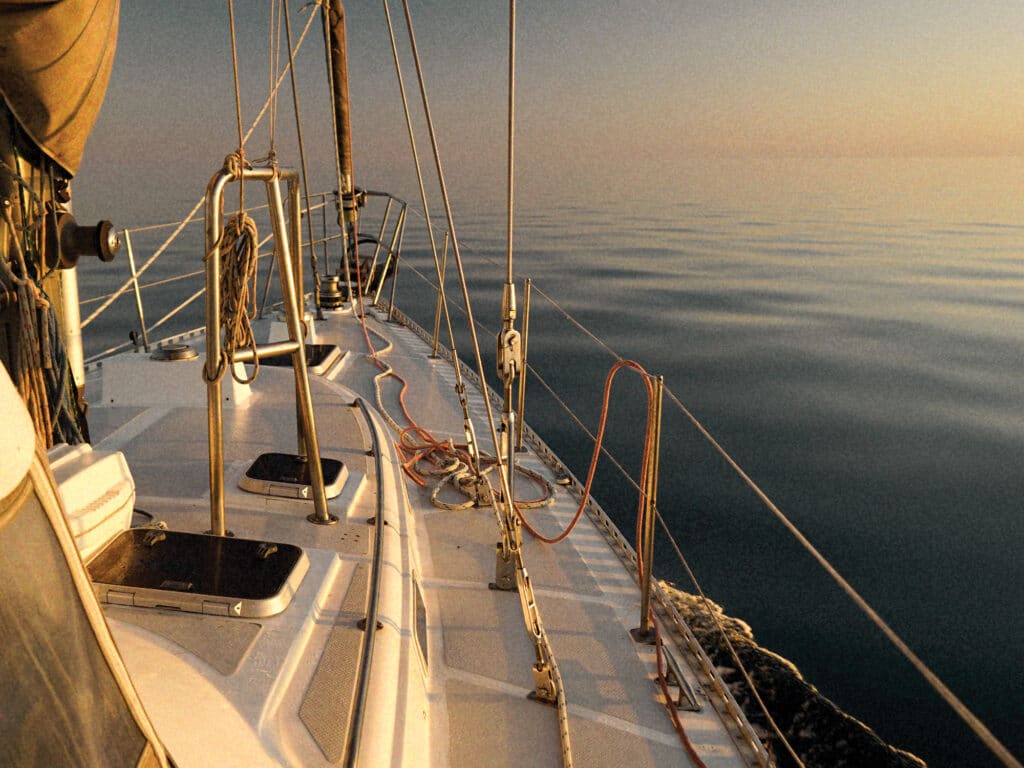
As a fellow cruiser gazed around the torn-up main cabin of our 1982 Stevens 47, Totem, his eyes grew wide. He asked a head-scratcher: “Why?”
Why not buy a newer sailboat? Why take on so much work? Why not be anchored at a remote Pacific Island right now instead of dry-docked in a dusty shipyard?
Because this boat—our home of 15 years through dozens of countries along a path around Earth, classroom for our three children, magic carpet to unimaginable experiences—is our Totem. Named as an homage to our home waters in the Pacific Northwest, the tribute became our truth. Totem is as much a symbol as a safe conveyance for our family. This boat has cared for us, and we now care for it, with a refit centered on its 40th year.
The Stevens 47 is a storied Sparkman & Stephens design, praised by experienced sailors for seaworthiness, sturdiness and performance. We dispute none of this, but even well-proven boats will age into meaningful needs. All materials degrade sooner or later, especially when they’re subjected to extended use in the harsh marine environment. Some boatbuilding practices become dated. Plywood-cored decks become spongy. Fiberglassed-in chainplates become a rusty, unsafe mess. Totem wasn’t built with either, but she has original flaws. Below the lovely teak and juniper cabin sole is a plywood subfloor that is delaminated and rotten in some areas. My husband, Jamie, has been known to quip that “everything on a boat is consumable.” And ultimately, it’s true.
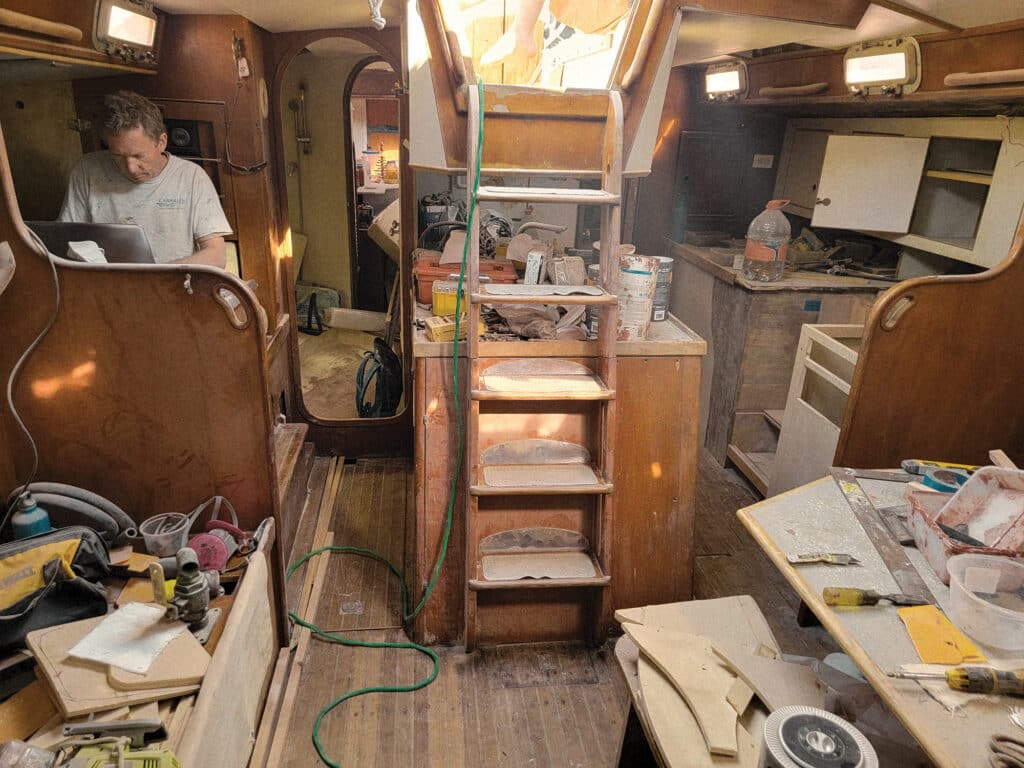
This isn’t Totem’s first refit; others took place under the care of prior owners, a history we’ve never fully unraveled. We’ve done several refits too. Back in 2007, the listing claimed the sailboat was “turnkey.” We found it necessary to add new standing rigging, sailhandling improvements and a working watermaker. Seven years in, another round was due in Thailand: replacing through-hulls, a failed stainless-steel water tank, and a fridge box with water-saturated foam insulation. Rerigging (again), a new watermaker (again) and new hatches were a big part of a 2019 refit in preparation for sailing across the Pacific. The pandemic scratched that plan, but it was nice to have the upgrades, regardless.
Sometimes, routine updates speak to good stewardship. When bronze fittings get a pink tone, it’s a red flag for deteriorating metal and time to replace the part—even if it looks fine. There can be spaghetti wiring with ghost wires that prior owners ignored rather than removed. Sometimes, we’ve had to make do with less-than-ideal materials or supplies; when a hidden flaw under the C-clip end of our steering chain failed off the coast of Colombia, spliced Dyneema was a quick and reliable solution that served for 5,000 nautical miles. We now have a new steering chain, a new 7-by-19 stainless-steel wire cables and an entirely new binnacle.
The 40-year refit is the biggest we’ve taken on, and was entirely unplanned. We sailed down the Sea of Cortez in Mexico in early 2021, with permits in hand to explore remote islands several hundred miles offshore. Just a few hundred miles in, our always reliable Yanmar 4JH3-TE with 8,300 hours on the clock manifested an unrepairable problem. Repowering is a big financial drain on the cruising kitty and, as it turned out, a big cost in time as well. Waiting for the new engine, we stumbled into additional, discretionary projects. Here’s a look at some of what we’ve been doing.
Repowering
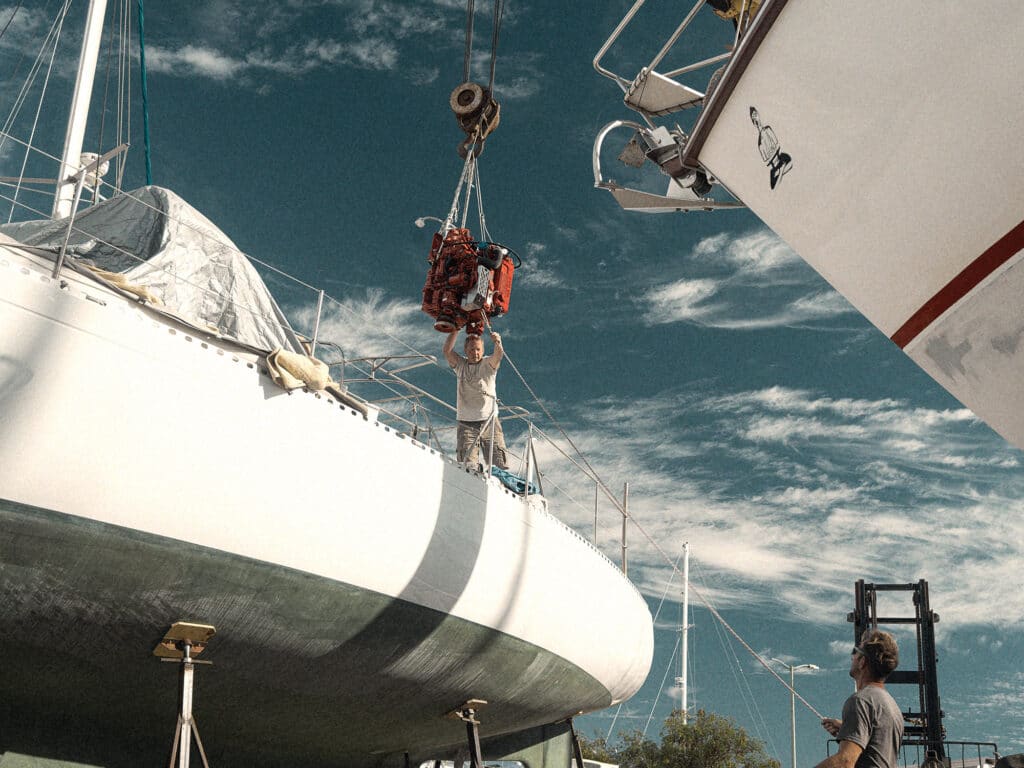
The engine problem that started this refit came to our attention when we discovered oil in the engine’s cooling system. Troubleshooting showed that the issue wasn’t the head gasket; instead, pinholes in the oil gallery leaked oil across to the cooling system. Five to eight hours of motoring was enough to make a gloppy mess of the coolant.
Totem had been repowered once before, around 2002—a major tick in her favor when we were boat shopping. But 20 years of active cruising later, the bill came due. A shiny new Beta 70 turbo is now aligned and mounted in Totem’s engine room, chosen for reliability and simpler routine maintenance.
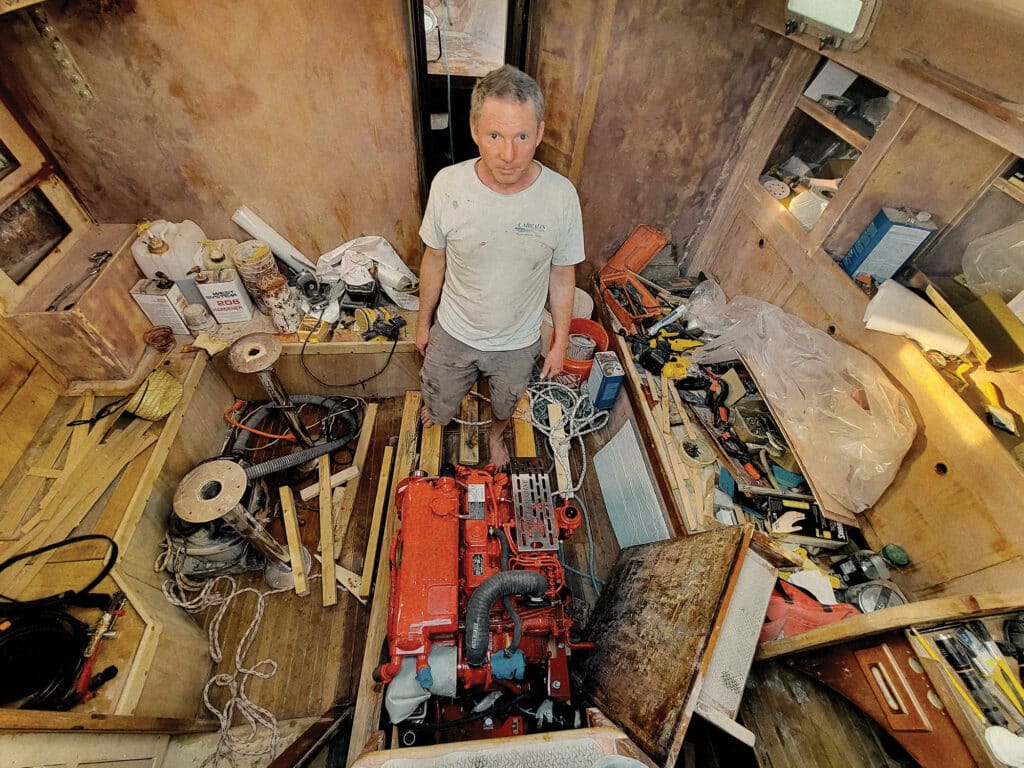
We also updated the engine-room insulation and engine-exhaust hose. The challenge of replacing 24 feet of 3-inch-diameter exhaust hose snaked through tight, hidden spaces brings to mind wrestling an alligator at night. We also replaced and sealed delaminated plywood, and the entire engine room is now painted glossy gray.
Hull Paint
Totem’s hull was a cosmetic disaster for years, and we’ve worn that scruffiness like a badge. Each scratch is the reminder of a dugout canoe that came to visit, or an enthusiastic fisherman who arrived to trade. But the paint wore through in places, exposing the original dark blue gelcoat. Even that was thin in places. It was becoming more than a cosmetic problem.
We hired crew at the Cabrales Boatyard in Puerto Penasco, Mexico, to prep (so much sanding and fairing), prime, and spray two-part topcoat. The hardest part was choosing which white to use. I wish that were a joke.
Cabin Rehabilitation
Global supply-chain issues caused refit delays that led to more refit projects. Every cabin is now included on the list. In the heads, the shower pans let water find a way to the adjacent bulkheads. (Shower pans, you had one job!) Over time, hidden sections of the bulkhead rotted. Even though we converted the forward wet head to be dry in 2007, the problem percolated out of sight. Removing the shower pans revealed rotten plywood subfloor. As with many projects, you start one and find four more.
Repairing the bulkheads was relatively easy. We removed the roughly 12-by-18-inch section in each, created a tapered edge, and then layered fiberglass down to the hull. In the forward head, the new plywood floor is sealed, fiberglassed with epoxy, and capped with tiles.
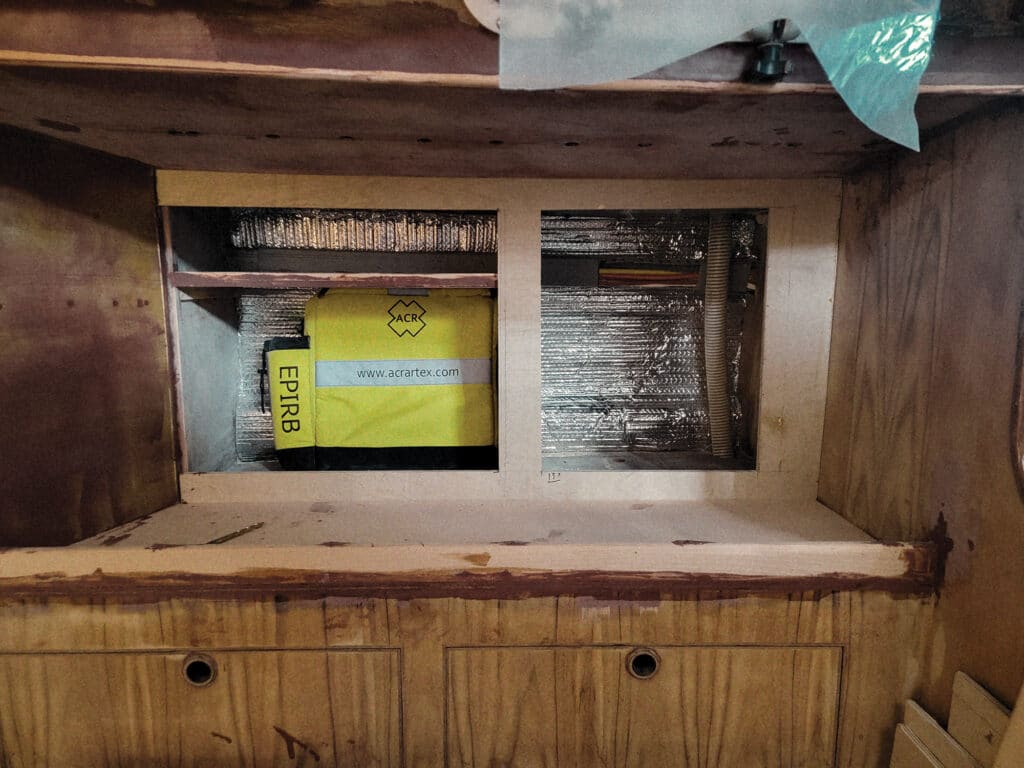
The aft head, which still has a shower, needed the pan improved. The original was board-flat, so water collected when Totem sat at a slight angle. The new pan has a distinct angle that actually drains. And the plywood subfloor was replaced.
We also fixed the original, cracked laminate surfaces that lined both heads. That job required a heat gun, metal scraper, and no small measure of blood, sweat and tears.
Surprisingly Consumable
Abovedecks, it’s easy to assume that a binnacle will last as long as a boat. Totem’s is original, and while it has served well, the chain cog and axle show notable wear, and the brake mechanism is so worn that it no longer secures the wheel. Plus, Jamie has never liked the design because of poor access to inspecting the inner mechanics.
Now, in its place, we have an Edson Vision II pedestal that opens easily for inspection.
Safety Issues
Fiberglass is flexible—to a point. Over 40 years, smooth water and big seas alike pressed or smashed into Totem’s bow. We now have slight oil canning, or waviness and distortion near the bow. The Stevens 47 hull is thick, but it still gets only so many million flexes before the resin degrades. And we have plans to carve through many more sea miles.
Reinforcing inside Totem’s hull at the bow to address the distortion opened up another opportunity: to install a crash box. Our friends recently suffered some scary damage to their 2008 Seawind 1160 when they hit an unidentified floating object north of Hawaii. That object ripped a hole in the starboard bow while they were 1,500 nautical miles from land. An effective crash bulkhead saved the vessel—and the crew—from needing rescue. We want that level of security too.
Safety updates are a theme we carried throughout this refit. Our old stainless-steel cockpit scuppers looked fine, but after removing them, we found them to be brittle and replaced them. Chainplate inspection is vital to a vessel’s safety, and we removed and inspected each one. Using a 10x magnifying loupe to examine them thoroughly, Jamie noted a few small areas (about ¼-inch in diameter) where shallow pitting started through the otherwise mirror finish. These minor areas of rust occurred where water must have leaked through. We used muriatic acid to eliminate the rust, and polished the chainplates with a progression of sandpaper, starting at 260 grit and going up to 3,000 grit, before reinstalling.
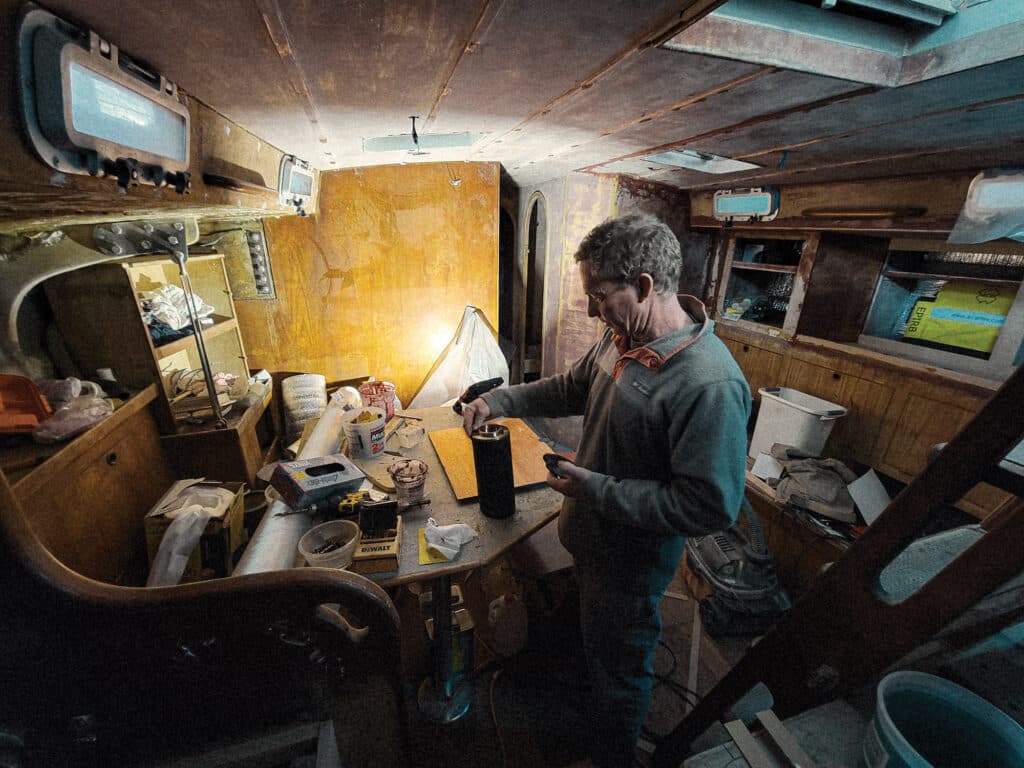
We switched out Totem’s rudder-shaft gland assembly, which required a complete redesign using off-the-shelf parts because a standard replacement was not available. We replaced the boot with a 4-inch-diameter exhaust hose and fabricated a new upper gland.
We upgraded our old ditch kit with ACR’s RapidDitch kit, and customized locker space near the companionway to accommodate it.
Headliner
I remember, when we purchased Totem, stepping belowdecks at a marina up the estuary in Alameda, California. The basket-weave-embossed vinyl headliner was permanently grubby. I thought, That will be the first to go.
It wasn’t essential, so it continued to irritate me for another seven years. We put in a Formica headliner in Thailand, which bought us time, but it wasn’t done right. We lived with it and thought about how we’d do it better someday.
Our extended stay at the yard has allowed us to tackle a lot of “someday” projects like this one. Jamie worked up a solution for the headliner by using ¼-inch plywood panels, cut to fit, and faired with West System epoxy and 407 filler. They create a super-smooth and tough finish. And the panels can be fabricated outside the boat, sparing grueling overhead sanding. The trick was securing the panels in place. They were too thin for screws. The solution Jamie landed on was wetting out fiberglass tape with epoxy, and forming ridged strips that bonded to the panels and ceiling. The only remaining work was to apply thickened epoxy on the seams.
Cabinets
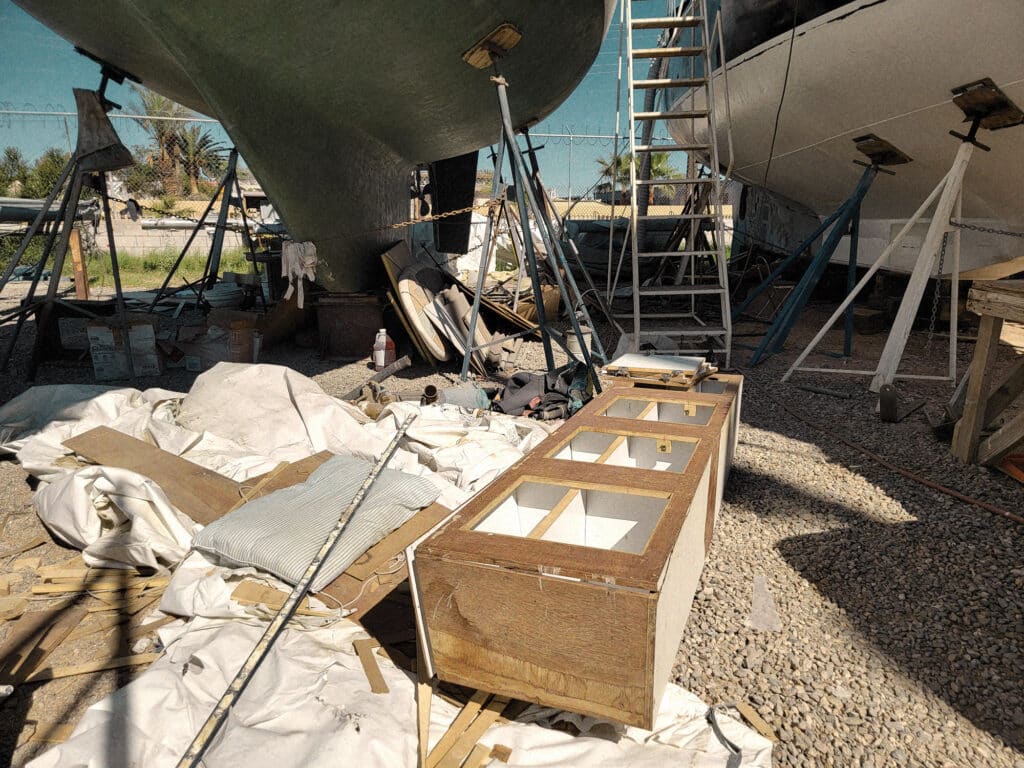
Totem’s main cabin has been through several iterations, each one tuned to the stage we found ourselves in life. In 2007, Jamie did a significant rebuild that took an 18-inch section of stowage out of the port side; moving the settee and table outboard allowed us to create midline seating for the family. It was a fantastic upgrade, and the shelves on the port hull were perfect for our children’s collections of books.
Fast-forward a few years: We opened up the space, giving our dwarf hamster a place to run as our need for printed books reduced. That change was effective, if a bit crude.
Now, with help from a skilled carpenter, that space is reconfigured again to retain stowage and bookshelves, with a finer finish.Similarly, in the aft cabin, we did a makeover of the cabinets and a desk space for our current needs.
Cockpit Comfort
Abovedecks, our dodger and Bimini top have been through several rounds of progressive improvement. The hard dodger crafted in 2007 now has fairing to clean up the rough underside, as well as improved stainless mounts. There are new snaps for the soft-sided dodger. A car-painting shop sprayed it with epoxy topcoat to gleaming perfection: It will now look like the dodger we always wanted, with molded-in grips that channel rain to the sides instead of sheeting it into the cockpit.
Swim Steps
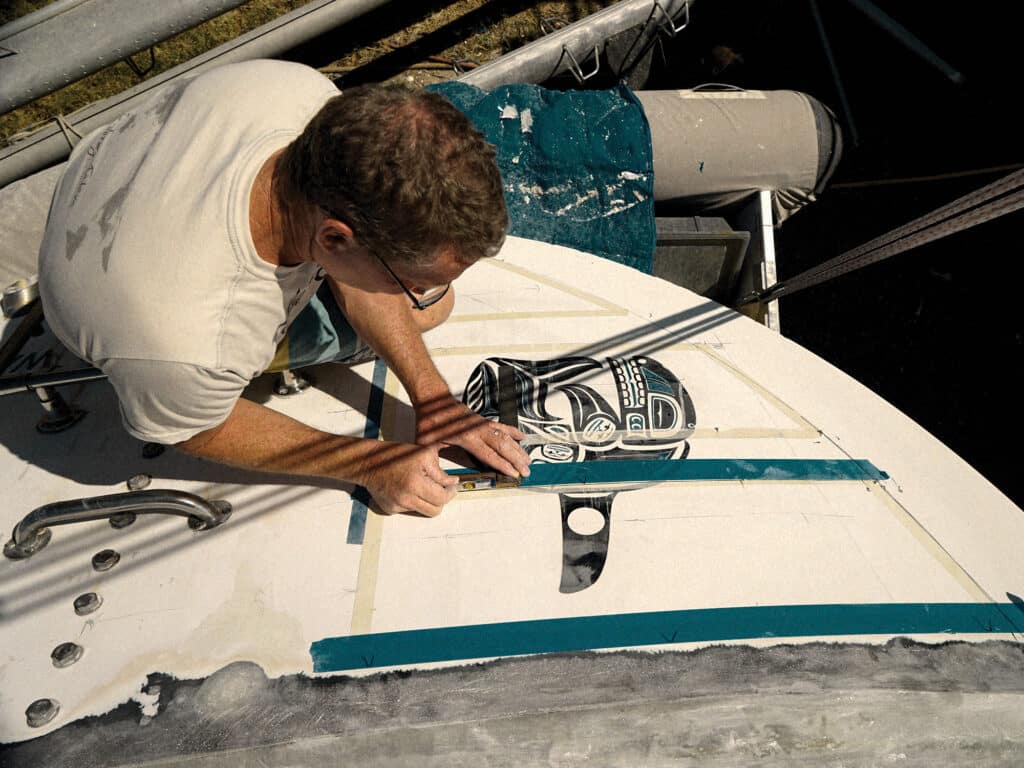
The most dramatic change was among the first that we tackled. We had been hauled out for only a few weeks when Jamie pressed an angle-grinder cutting disc into Totem’s transom. Years of pondering how to make it a better platform for entering and exiting finally landed on a clever approach.
He perched on a ladder against our reverse transom, a legacy of 1970s design, and created steps that would appear as if they are carved into the back. Partway through, I described my vision for sitting back there, feet in the water, enjoying morning coffee and a view. The bottom step then became a swim platform.
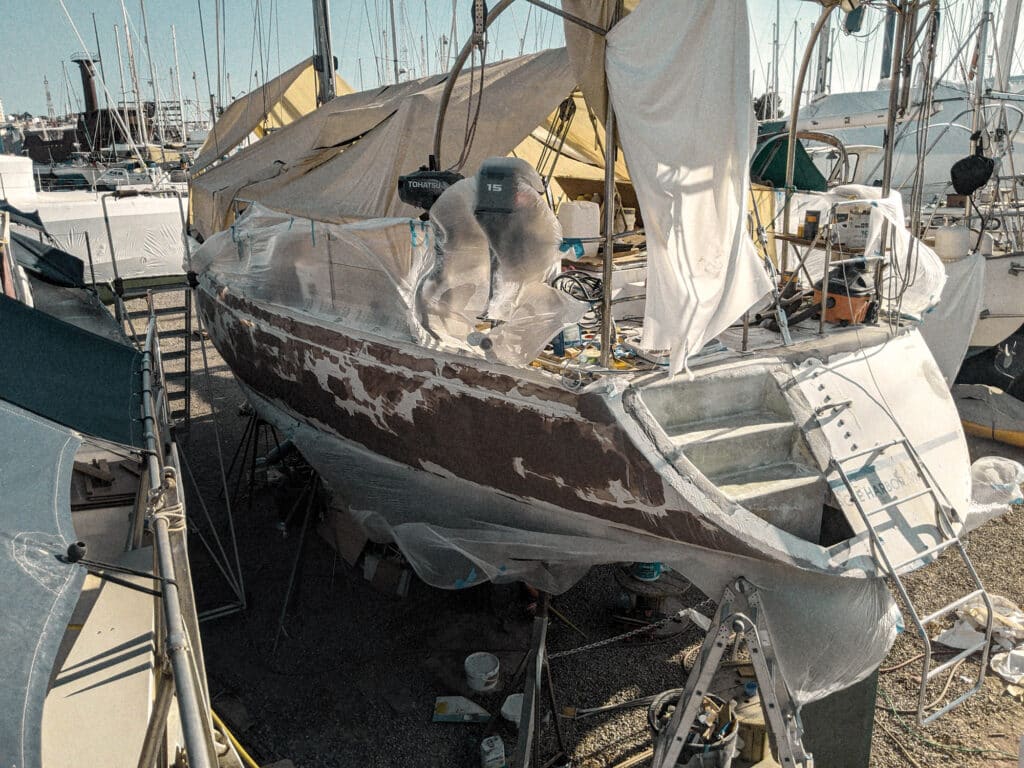
This upgrade has created a new space for us to enjoy life afloat. It eliminated the awkward, perpetually rusting stainless-steel ladder, and gave us bonus space in the propane locker, which is about 20 percent larger.
Reaching The End
“When will you splash Totem?” is the question we hear repeatedly. “It’s a 40-year refit, so only 38 years to go,” Jamie replies with a weary, wry smile.
The timeline has extended far beyond anything we imagined. The delays answer the question of why cutting the dock lines can be so hard for cruisers. Life gets in the way. There was a pandemic. Our daughters went off to college and life on land. There were unanticipated delivery delays. And it was an important time to be in reach of my parents. We could not have known that these two years in the shipyard would be my mother’s last two on Earth; to be in reach for easy visits was priceless. She passed away early this year.
But ultimately, Jamie and I are on no timeline but our own. As we reach the point of being ready enough, the islands beckon, and we’ll soon point their way.
Galley Upgrades
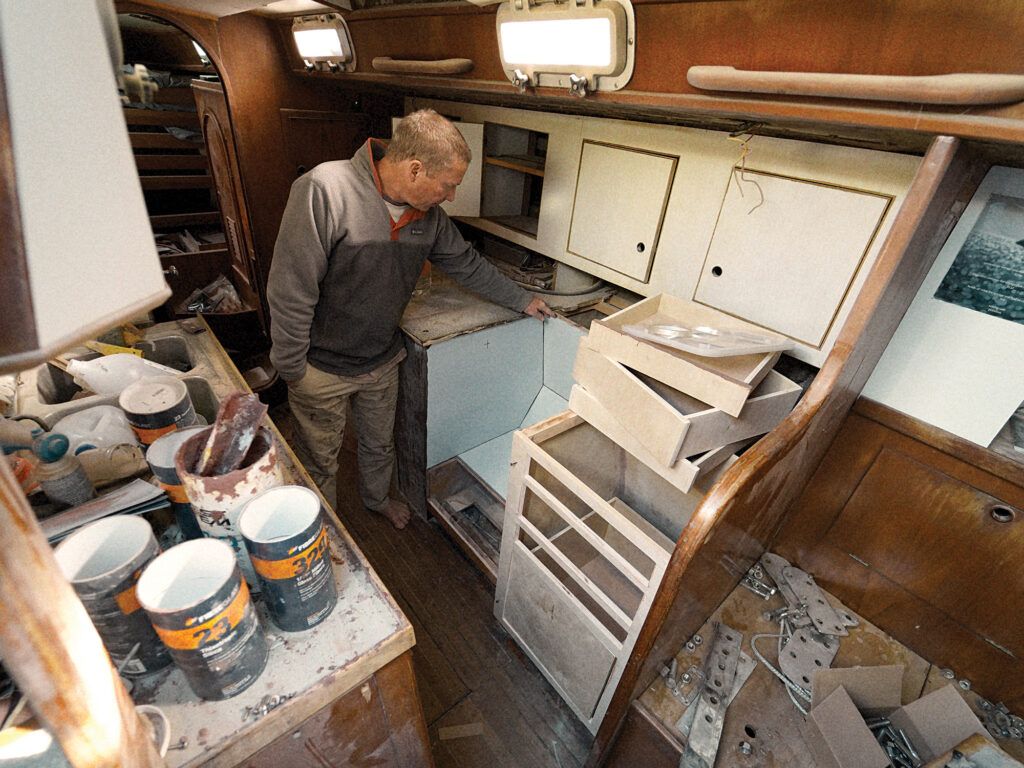
While every cabin on Totem is part of the refit, changes to the galley crept up on us. At first, we focused entirely on nondiscretionary needs. The Force 10 we installed in 2007 was on its last legs, and was not practically repairable. The laminate countertop installed in 2014 in Thailand was wearing through enough to expose particleboard—that had to go. Jamie fell through dry-rotted stringers under the sole—looks like that would have to be replaced!
Discretionary updates crept in, easily justified. The new stove’s geometry would let us reclaim precious inches of workspace at the forward end by rebuilding a cabinet, turning it from skinny to functional. Then, when pulling off the laminate—why not just pull the whole countertop and reimagine a better use of the storage spaces below? That engine compartment (the whole inboard side of the galley) needed to be gutted for the new Beta anyway. It wasn’t long before the only remaining part of the galley we weren’t tearing into were the lockers along the port hull—and it had always bothered Jamie how when they were rebuilt in 2014, they weren’t to his spec, leaving yawning portals to unrealized storage.
Suddenly we were looking at our galley as a near-rebuild, not a few fixes. But a love for cooking and eating well, and no additional time cost to the haulout, made it easy to embrace expanded plans.
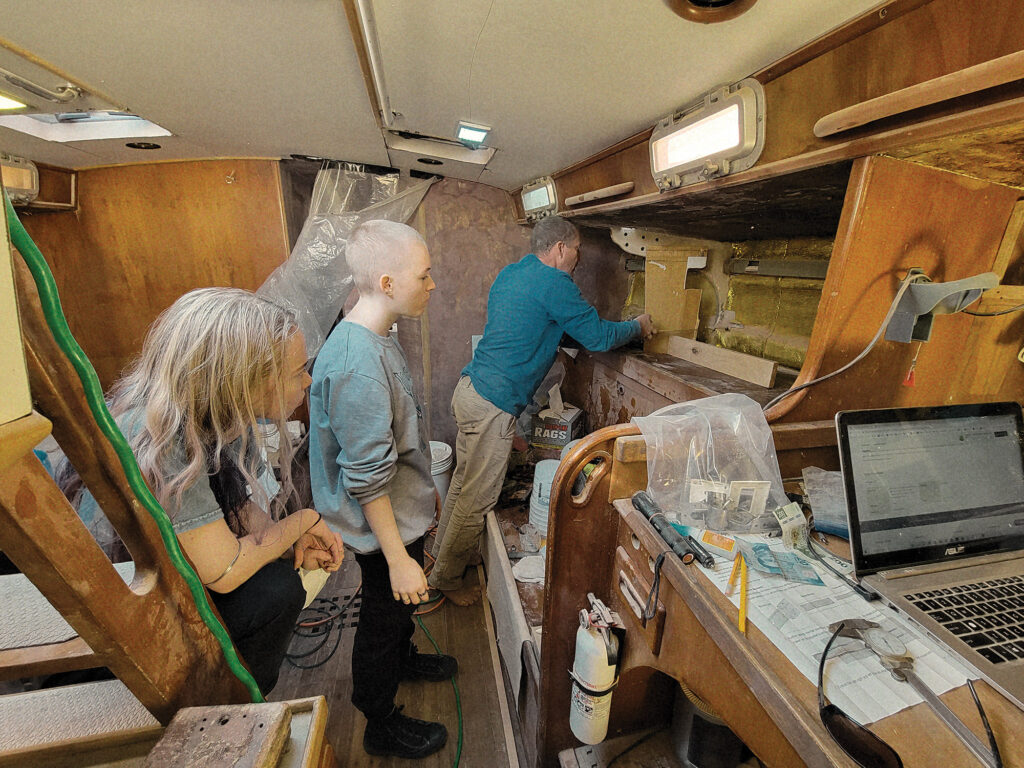
The first splurge was a GN-Espace stove. This UK-made “cooker” is a rarity among boat ovens—it’s actually insulated. This means baking in the tropics without heating the boat, and vastly more efficient use of propane. I can’t wait to hone my sourdough skills from the tropics!
Countertop material has been the hardest to settle on. For months, installing quartz—a manufactured product from stone powder and resin—was the plan. But it’s too heavy: not because of the weight overall (we determined it to be about the same as having another person on board), but the heft needed to lift the slab for refrigerator access, or a large square to reach the garbage can hidden beneath. Solid surfacing was our second choice, but there isn’t an installer/fabricator or supplier in this part of Mexico—and it’s not a material we’d like to tackle as amateurs. We decided on bamboo. Strips of the grass bonded to form a slab creates the lightest-weight countertop among all options (save laminate), with the benefit of being relatively thin—an asset because we seek to avoid adding height. The environmentally friendly option feels and looks good.
Cabin-sole replacement has been a trickier proposition than expected. We could never match the teak and juniper elsewhere on Totem; attempting it would look awkward. Casting for options, we initially chose recycled rubber tiles, but Jamie and I kept returning to memories of the cork flooring we loved in our Seattle kitchen: It is comfortably resilient underfoot, handles traffic well (hiding grime from toddlers and dogs), and is a renewable material that we can feel good about. Finding glue-down tiles intended for use in high-moisture settings (such as a bathroom…or a sailboat!) settled the choice.
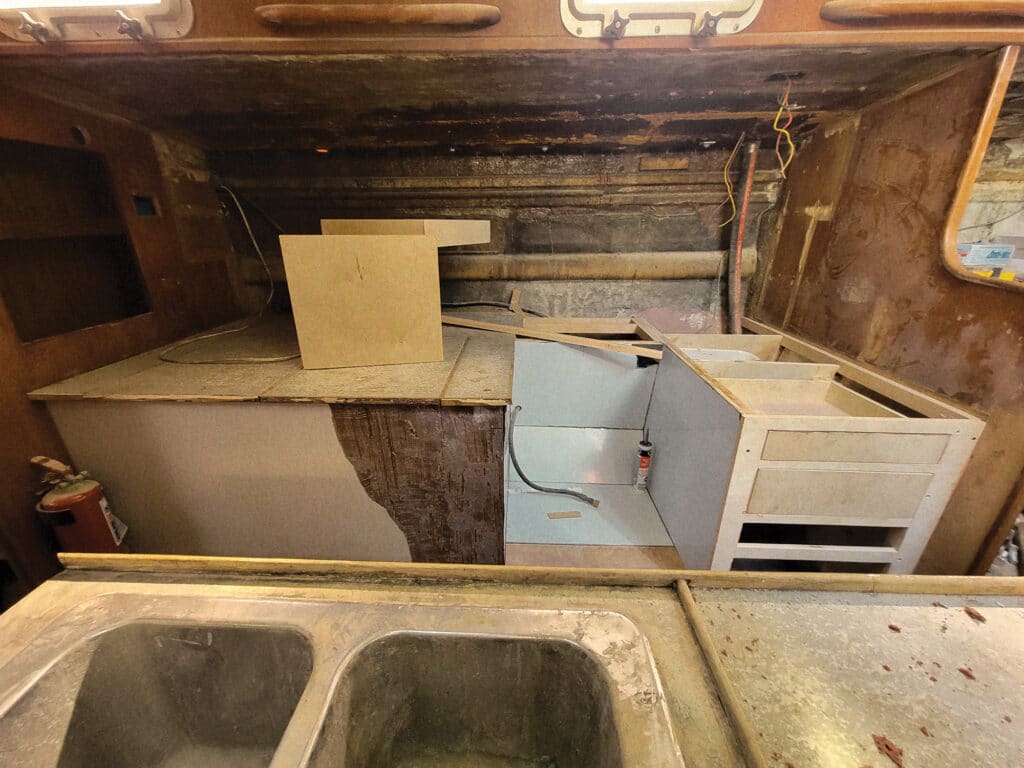
Finally, there is literally the kitchen sink thrown in. With new counters and fresh finishes everywhere else in the galley, that 1982 sink was going to look pretty out of place. Jamie jokingly refers to our new sink as “The Bathtub.” And while the household size might be inordinately large on a sailboat, it fits, it has fantastic utility with nested cutting boards and drainage, and we know from our prior use patterns that we’ll appreciate the capacity. —BG
A Paean to Sanding
It’s ironic that making Totem better requires removing so much of Totem in a slow, agonizing process. I’m referring to sanding. I hate sanding. I recall learning this as a 7-year-old kid; sandpaper wrapped around the wooden block, cleaning the gunwales of an old wooden skiff in my backyard. At 13, I rebuilt the centerboard trunk on my Enterprise-class sailing dinghy and produced an astonishing quantity of dust. My summer job at age 18 was preparing boats in a shipyard for spring launch in Mystic, Connecticut. Wet sanding bottom paint is a grueling, messy business. Almost four decades later, this refit on Totem is one epic, tedious, awful sanding event. Countless coarse 60- and 80-grit sander disks, cut through rough surfaces. An eternity of 120-grit sheets. When the dust settled, I learned to row in that wooden skiff. I learned to race the wind in that sailing dinghy. Totem might be a dusty mess, but I wouldn’t have it any other way.—Jamie Gifford








